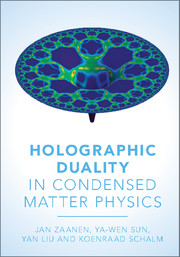Book contents
- Frontmatter
- Contents
- Preface
- 1 Introduction
- 2 Condensed matter: the charted territory
- 3 Condensed matter: the challenges
- 4 Large-N field theories for holography and condensed matter
- 5 The AdS/CFT correspondence as computational device: the dictionary
- 6 Finite-temperature magic: black holes and holographic thermodynamics
- 7 Holographic hydrodynamics
- 8 Finite density: the Reissner–Nordström black hole and strange metals
- 9 Holographic photoemission and the RN metal: the fermions as probes
- 10 Holographic superconductivity
- 11 Holographic Fermi liquids: the stable Fermi liquid and the electron star as holographic dual
- 12 Breaking translational invariance
- 13 AdS/CMT from the top down
- 14 Outlook: holography and quantum matter
- References
- Index
8 - Finite density: the Reissner–Nordström black hole and strange metals
Published online by Cambridge University Press: 05 November 2015
- Frontmatter
- Contents
- Preface
- 1 Introduction
- 2 Condensed matter: the charted territory
- 3 Condensed matter: the challenges
- 4 Large-N field theories for holography and condensed matter
- 5 The AdS/CFT correspondence as computational device: the dictionary
- 6 Finite-temperature magic: black holes and holographic thermodynamics
- 7 Holographic hydrodynamics
- 8 Finite density: the Reissner–Nordström black hole and strange metals
- 9 Holographic photoemission and the RN metal: the fermions as probes
- 10 Holographic superconductivity
- 11 Holographic Fermi liquids: the stable Fermi liquid and the electron star as holographic dual
- 12 Breaking translational invariance
- 13 AdS/CMT from the top down
- 14 Outlook: holography and quantum matter
- References
- Index
Summary
The material systems studied in condensed matter laboratories are formed from a finite density of conserved entities such as the number of electrons or (cold) atoms. This is a priori quite distinct from the vacuum states which have been discussed in the previous two chapters. These purely scaleless critical states can be mimicked in the laboratory, but this involves meticulous fine tuning to the critical point. The famous example is the cold-atom superfluid Bose Mott-insulator system [319]. As we discussed in chapter 2, according to the established wisdom of condensed matter physics the zero-temperature states of matter which are understood, are generically stable or “cohesive” states. These typically break symmetry spontaneously, with a vacuum that is a short-range entangled product state. In addition, the Fermi liquid and the incompressible topologically ordered states are at present understood as stable states that are “enriched” by the long-range entanglement in their ground states. Finally, by fine tuning of parameters one can encounter special unstable states associated with continuous quantum phase transitions, but these are understood within the limitations of “bosonic” field theory, which relies on the statistical physics (in Euclidean space-time) paradigm.
The AdS/CMT pursuit was kickstarted in the period 2008–2009, inspired by this finite-density perspective underlying condensed matter physics. The first shot was aimed at spontaneous symmetry breaking: the holographic superconductor.We shall discuss this at length in chapter 10. We will find out there that much of the physics of this iconic zero-temperature state of matter is impeccably reproduced by holography, with the results acting thereby as a powerful confidence builder. However, in the development that followed it became increasingly clear that holography insists on the existence of an entirely new class of “non-cohesive” finite-density states at zero temperature. These emergent quantum critical phases are best called “strange metals” [159, 320]. This quantum criticality is not tied to the conformal invariance and supersymmetry of the zero-density CFT inherent in the AdS/CFT name.
- Type
- Chapter
- Information
- Holographic Duality in Condensed Matter Physics , pp. 259 - 290Publisher: Cambridge University PressPrint publication year: 2015



